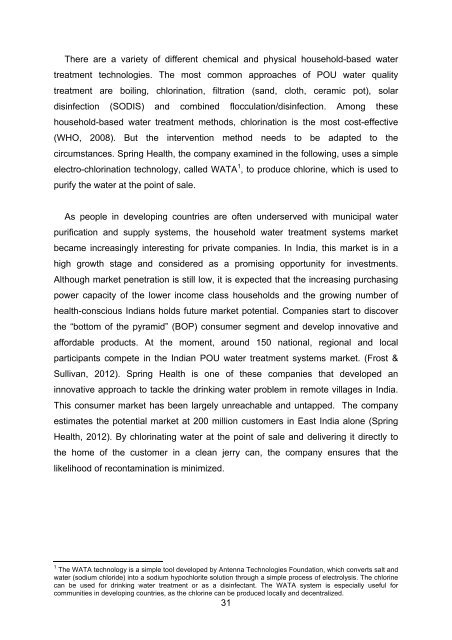Social Marketing for Safe Water
Download Study Springhealth - Market approaches to development
Download Study Springhealth - Market approaches to development
You also want an ePaper? Increase the reach of your titles
YUMPU automatically turns print PDFs into web optimized ePapers that Google loves.
There are a variety of different chemical and physical household-based watertreatment technologies. The most common approaches of POU water qualitytreatment are boiling, chlorination, filtration (sand, cloth, ceramic pot), solardisinfection (SODIS) and combined flocculation/disinfection. Among thesehousehold-based water treatment methods, chlorination is the most cost-effective(WHO, 2008). But the intervention method needs to be adapted to thecircumstances. Spring Health, the company examined in the following, uses a simpleelectro-chlorination technology, called WATA 1 , to produce chlorine, which is used topurify the water at the point of sale.As people in developing countries are often underserved with municipal waterpurification and supply systems, the household water treatment systems marketbecame increasingly interesting <strong>for</strong> private companies. In India, this market is in ahigh growth stage and considered as a promising opportunity <strong>for</strong> investments.Although market penetration is still low, it is expected that the increasing purchasingpower capacity of the lower income class households and the growing number ofhealth-conscious Indians holds future market potential. Companies start to discoverthe “bottom of the pyramid” (BOP) consumer segment and develop innovative andaf<strong>for</strong>dable products. At the moment, around 150 national, regional and localparticipants compete in the Indian POU water treatment systems market. (Frost &Sullivan, 2012). Spring Health is one of these companies that developed aninnovative approach to tackle the drinking water problem in remote villages in India.This consumer market has been largely unreachable and untapped. The companyestimates the potential market at 200 million customers in East India alone (SpringHealth, 2012). By chlorinating water at the point of sale and delivering it directly tothe home of the customer in a clean jerry can, the company ensures that thelikelihood of recontamination is minimized.1 The WATA technology is a simple tool developed by Antenna Technologies Foundation, which converts salt andwater (sodium chloride) into a sodium hypochlorite solution through a simple process of electrolysis. The chlorinecan be used <strong>for</strong> drinking water treatment or as a disinfectant. The WATA system is especially useful <strong>for</strong>communities in developing countries, as the chlorine can be produced locally and decentralized.31



